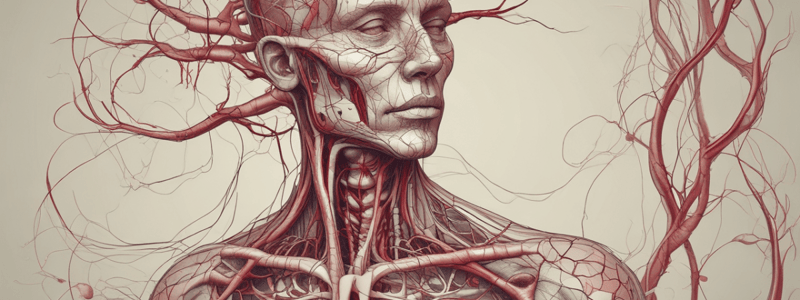Podcast
Questions and Answers
What is the primary function of the tunica media in blood vessels?
What is the primary function of the tunica media in blood vessels?
- To contain elastic fibers that aid in vessel expansion and contraction (correct)
- To keep blood flowing smoothly
- To provide structural support to blood vessels
- To regulate blood pressure
What is the name of the smallest branches of arteries?
What is the name of the smallest branches of arteries?
- Tunica intima
- Arterioles (correct)
- Capillaries
- Venules
Which blood vessel has the thickest walls?
Which blood vessel has the thickest walls?
- Veins
- Arteries (correct)
- Capillaries
- Venules
What is the primary function of the tunica intima?
What is the primary function of the tunica intima?
What is the name of the layer that contains nerves and tiny vessels?
What is the name of the layer that contains nerves and tiny vessels?
What is the primary function of capillaries?
What is the primary function of capillaries?
What type of blood does the pulmonary artery carry?
What type of blood does the pulmonary artery carry?
What is the name of the smallest branches of veins?
What is the name of the smallest branches of veins?
What is the primary function of veins?
What is the primary function of veins?
What is the outer layer of blood vessels also known as?
What is the outer layer of blood vessels also known as?
Flashcards are hidden until you start studying
Study Notes
Blood Vessels
- Blood vessels are responsible for delivering oxygen to vital organs and tissues and removing waste products.
- There are three main types of blood vessels: veins, arteries, and capillaries.
Structure of Blood Vessels
- Blood vessels have three layers of tissue:
- Tunica intima: inner layer that regulates blood pressure, prevents blood clots, and keeps toxins out of the blood.
- Tunica Media: middle layer that contains elastic fibers to keep blood flowing in one direction and helps vessels expand and contract.
- Tunica Adventitia (or Tunica Externa): outer layer that delivers oxygen and nutrients to cells, removes waste, and provides structure and support.
Arteries
- Lead away from the heart.
- Carry oxygenated blood to the body, except for the pulmonary artery which carries unoxygenated blood to the lungs.
- Have thicker walls than veins to resist strong blood pressure.
Veins
- Carry blood towards the heart.
- Contain valves to prevent backflow due to gravity.
- Carry deoxygenated blood from the body to the heart and oxygenated blood from the lungs to the heart.
- Have thinner walls than arteries.
Capillaries
- Smallest blood vessels that connect arterioles to venules.
- One cell thick.
- Site of exchange for gases, nutrients, waste products, and other substances.
- Blood in the capillary bed is a mixture of arterial and venous blood.
Studying That Suits You
Use AI to generate personalized quizzes and flashcards to suit your learning preferences.




